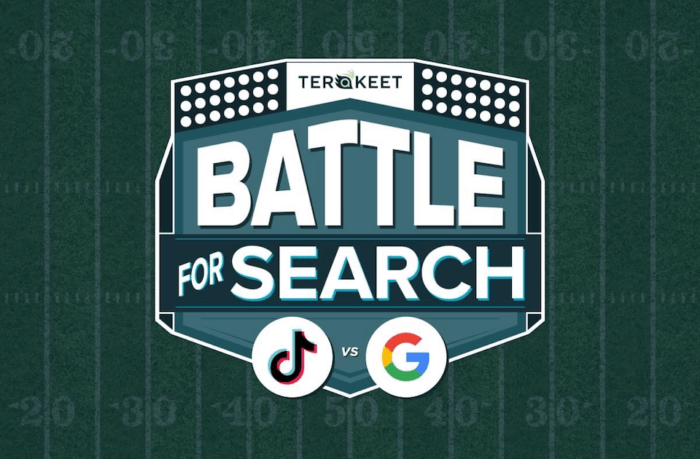
The Truth About Gen Z, Google, & TikTok’s Search Engine
Oct 4, 2022|Read time: 7 min.
Key Points
- TikTok is an unrivaled platform for influencer marketing, user-generated content (UGC), and specific transactional content.
- Google is the organic search category king (92% market share) that allows you to reach customers at any sales funnel stage.
- For certain demographics looking for certain things, TikTok is powerful. Ultimately, though, TikTok is just one tool while Google is the entire toolbox.
Several media sites have reported that TikTok, owned by parent company ByteDance, is now the top search engine for Generation Z, beating Google at its own game. The hype surrounding these TikTok vs. Google claims was sparked by two events: a simple tweet stating, “I don’t Google anymore, I TikTok,” and a TechCrunch interview with a Google executive.
At first glance, TikTok’s gains among Gen Z users are intriguing, but there’s much more to the story. These articles are missing some key details that deserve more investigation.
Comparing the TikTok search engine to Google is an apples-to-oranges endeavor. Here’s why:
- TikTok is highly effective for UGC and transactional online searches through influencers. But it only reaches the very top and bottom of the sales funnel.
- Google still controls almost all of the search market share, with at least two trillion searches per year.
- TikTok content is disposable, short-lived, and built for quick hits of entertainment.
- TikTok is a video search engine, which limits its ability to reach customers throughout the funnel. It’s also less accessible depending on one’s learning style or ability. Google offers all content types.
- Optimized assets and great content on Google last forever and build brand trust.
- Marketers can rank full-funnel content — top-of-funnel (TOFU) informational content, mid-funnel (MOFU) lead-nurturing content, and bottom-of-funnel (BOFU) transactional content — on Google.
But none of these facts mean you should ignore TikTok, especially if you want to reach younger users.

TikTok is an ecommerce powerhouse (for certain things)
For UGC and influencers, TikTok is a powerful platform for generating transactional behavior. Plus, unique affiliate services like likeshop.me have grown up around TikTok. It’s now much easier for influencers to monetize their content.
For brands that use influencer marketing, TikTok can drive brand awareness and sales. Due to the high percentage of Gen Z users, TikTok is a great way to get in front of young users. This group is a highly engaged and profitable demographic.
Digging around on TikTok indicates that there is a lot of searching going on, including TOFU and BOFU intent. You can quickly get an idea of what’s popular, what’s being searched, and who the key influencers are in a given space.
Let’s take a look at a hypothetical search, from query to transaction, via TikTok (shown below):
- TikTok user searches for a product or interest in TikTok’s search bar.
- User finds content generated by influencers and TikTok content creators.
- User finds a short video with specific product reviews.
- The content creator may have the recommended products listed on their profile.
- User finds the product they’re looking for and follows a link directly to a product page or amazon.
- The user buys the product, and the content creator who recommended it gets a cut.

The user journey mapped out above shows the transactional power of TikTok. Depending on the influencer’s profile setup, there are six or less steps from search to transaction. Plus, the entire flow is backed up by the influencer’s social proof.
But Google is the clear category king
There’s no way to deny the utility of TikTok for transactional search and the value it provides as a search option. In certain verticals, TikTok has impacted Google’s dominance.
According to Google’s Senior Vice President Prabhakar Raghavan, “In our studies, something like almost 40% of young people, when they’re looking for a place for lunch, they don’t go to Google Maps or Search,” he continued. “They go to TikTok or Instagram.”
And while Google has confirmed these trends, there is little evidence that these incremental changes actually threaten Google’s unprecedented 90%+ market share. Or that TikTok is even operating in the same market category.
TikTok is a piece of the marketing puzzle, but the vastness of Google — its full-funnel capabilities, its algorithm, its focus on useful content and refined search intent knowledge, its constant evolution, and the lifespan of the content that ranks — makes it so much more.
Organic search is an entire marketing channel and Google is just a platform. But Google’s dominance positioned it as the channel itself. This is unlikely to change.
TikTok search engine vs. Google’s Search algorithm
The Google vs. TikTok search engine battle is highly misleading because the platforms have different purposes. Google and TikTok operate in their own unique spheres. Each platform has unique algorithms, varying search intent targeting, different types of authenticity vetting, different end goals, and unique values. This puts a limit on how much direct competition occurs in a TikTok vs. Google face-off.
For example, Google’s search results are considered a much more trustworthy news source, while TikTok’s search engine doesn’t penalize content for misinformation.
We can make a similar argument about the Amazon vs. Google debate.
Popularity vs. Quality
- The TikTok search algorithm prioritizes user engagement on content, showing the most popular videos to more people. However, this type of reward system is easily gamed with thumbnail clickbait and hijacked hashtags.
- Google’s Search algorithm initially used keywords and links exclusively to rank content which was easily gamed by savvy SEOs. Now, it looks at search intent, relevance, usefulness, trust, and user experience.
Popularity vs. Trust
- TikTok video content vetting is based almost entirely on social proof. This means users with large followings, big video views, and engagement, and other popularity metrics become the most trusted.
- Google vets content based on Expertise, Authoritativeness, and Trustworthiness (E-A-T), among other trust metrics, pushing up content from authoritative, expert sources.
Entertainment vs. Utility
- TikTok is, first and foremost, an entertainment-based social media platform designed to hold user attention for as long as possible, upping the potential for transaction and user growth.
- Google, as a search engine, is the most authoritative aggregator and prioritizer of all web-based content, ranked to match your intent, and pointing you to the most useful resource for a given query.
Value for brands – TikTok vs. Google
- TikTok offers: High engagement and virality on entertaining content, access to influencer and affiliate channels, access to Gen Z audience, and low-cost though short-lived, individual content marketing opportunities.
- Google offers: Full-funnel customer reach from awareness to conversion, high rank for authoritative content sources, a platform for long-term brand narrative control and reputation protection, and readily available, current and historic search data.
- Google search intent: A unique and incredibly powerful Google ranking factor is the customer intent data that can be pulled by brands. With the right tools and expertise, you can learn what your customers are looking for, where these intents land on the funnel, and use these insights to determine what content to create to meet their needs in real-time. This is unlike almost any other platform, including TikTok.
The Brand Intelligence Report
Exclusive AI insights, search trends, and brand strategies, delivered to your inbox.
Building a holistic strategy
A holistic marketing strategy includes leveraging every single channel and being everywhere that’s appropriate. To truly be effective, brands must be ever-present at all stages of the conversion funnel to provide customer value when and where they ask for it.
Anyone who suggests either extreme, that TikTok doesn’t matter or that TikTok is the end-all-be-all of search, is not operating from a full-funnel mindset, and will ultimately limit their own impact.
A middle road, inclusive of Google, TikTok, and any other platform your customers inhabit in order to cast the widest (though intentional) net will likely be more effective.
The first step is understanding and acknowledging that different digital marketing channels offer different types and magnitudes of value.
Final thoughts on the TikTok search engine
The growth of TikTok’s video search engine among Generation Z and younger audiences is a great thing for marketers, but it doesn’t threaten Google’s reign as the tech giant of organic search.
As explained above, there are major differences when discussing TikTok vs. Google. It’s a bit of a category error to place them in the same lane.
A good strategy is continuing to pursue full-funnel marketing through Google, but also adding TikTok to the mix.
Every platform poses a unique value, and each can have a substantial impact for brands. But at the end of the day, the combined power of content across many platforms and channels — the holistic strategy — again and again proves its value.




